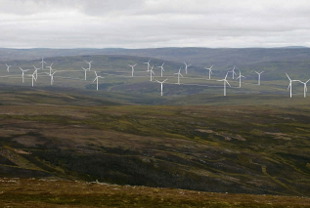The SSE statement said that the proposed Dalnessie wind farm, along with another at Fairburn in Easter Ross, is no longer financially viable. In reaction to the decision by SSE, Chris Townsend, spokesman for the SMM campaign, said: “SSE saw the writing on the wall and we ask that RWE do the honourable thing – given that the damage to wild land and the Park would be extreme – and withdraw their application immediately.”
The proposed Dalnessie wind farm would have seen 27 turbines erected and the excavation of thousands of tonnes of rock and the construction of tens of kilometres of new access roads within a spectacular wild landscape.
If permission is granted, the Allt Duine scheme will see 7.5km of new roads, up to 15m in width, cut into the Park’s hills, with kilometres of cabling, a site reception, cement batching plant and temporary construction compound within the Park – on a site just 400m from the National Park boundary. The turbines would be visible from 25,790ha of the Park, including iconic high points like the Ptarmigan Restaurant and popular Munros within the Park such as Ben Macdui, Cairn Gorm and Braeriach. The Park and the effected national scenic area are supposed to be protected by national and local planning policy.
Chris Townsend added: “Though RWE never tire of trying, it is not credible to argue that the wind farm’s impact on the National Park can be overcome.
“Whatever the official reason given for the SSE decision, it is clear that RWE are peddling a pipe dream. The cabling, roads and turbines will have an irrevocable impact on the landscape, wildlife and ornithology of the Park and the Monadhliath Mountains – an area that the Scottish Government wishes to protect through its new Core Wild Land Area policy.
“The weight of opinion is firmly against the Allt Duine wind farm proposal. Statutory consultees like the Cairngorms National Park Authority, Scottish Environment Protection Agency and The Highland Council stand shoulder-to-shoulder with the public and interest groups like the John Muir Trust and Mountaineering Council of Scotland against this scheme because it is a step too far by the wind industry.”
The SMM campaign believes, like other stakeholders like the John Muir Trust, that there is a need for the Core Areas of Wild Land map, developed by Scottish Natural Heritage, to be incorporated into the Scottish National Planning Framework, to provide clarity for developers, councils and planning officials, and to discourage speculative, time-consuming section 36 applications.

